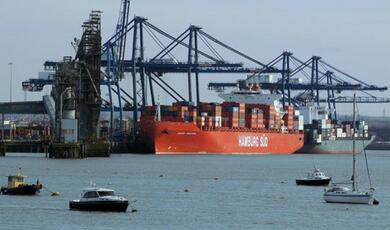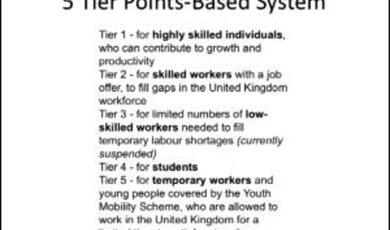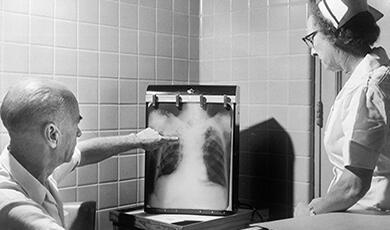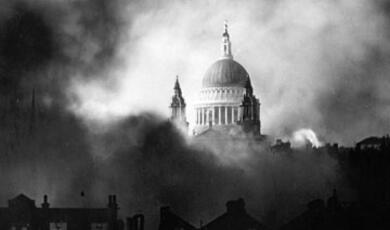Apprenticeship in early modern London: The economic origins and destinations of City apprentices in the 16th and 17th centuries
Share
- Details
- Text
- Audio
- Downloads
- Extra Reading
The prospect of an apprenticeship attracted thousands of youths to the guild masters of early modern London. Where did apprentices come from, what became of them in the city, and how did this system impact shape the development of Europe’s largest city? The presenters will draw on their recent research to illustrate the economics of craft apprenticeship, and the interaction of this training institution with economic change prior to industrialisation.
Download Text
26 January 2012
Apprenticeships in Early Modern London:
Economic Origins and Destinations of
Apprentices in the 16th and 17th Centuries
Dr Patrick Wallis & Dr Christopher Minns
I saw that in the programme our lecture was categorized as ‘London’; ‘History’; and ‘Unusual’. I’m not sure what we did to deserve that last description. Hopefully, you’ll find it interesting, more than unusual.
Apprenticeship is a very appropriate subject for a lecture here in Gresham College. Thomas Gresham was himself an apprentice – unusually enough, for he had also spent time at Cambridge, and his respect for university learning is apparent in the professorships he endowed here at Gresham College. But in 1535 he was apprenticed to his uncle, John Gresham. As he explained, this was in order to obtain the practical skills he needed as a merchant: “I need not have bynne prentisse for that I was free by my Father's coppye: albeit my Father Sir Richard Gresham being a wyse man, although I was free by his coppye, it was to no purpose, except I was bound prentisse to the same; whereby to come by the experience and knowledge of all kinds of merchandise.” (Burgon, 1.47)
It is this kind of practical apprenticeship – in trades as well as crafts, for the sons of labourers as well as the sons of knights – that we will discuss tonight. Our ambition this evening is to convey some of the realities of apprenticeship – and dispel a few myths and easy generalisations along the way.
The myths and assumptions are many:
I could go on. Like all myths, most of these have a grain of truth in them, as we will see. But the story we want to give here of apprenticeship should sound rather different.
It is a story about an institution that was large. Apprenticeship in London made the capital into the largest educational site that existed in England before compulsory basic schooling was introduced in the late 19th century. The share of the population who were trained in the city exceeded the proportion going to university before the 1980s.
It is a story about an institution that was flexible. London apprentices were highly mobile – they often changed who they trained with, they often quit or travelled to other workshops to train.
And it is a story about an institution that allowed London’s, and Europe’s, economies to slowly grow into the world we enjoy today. Apprenticeship was one of the features that separate Europe from Asia; and that helped Europe develop in the 18th and 19th centuries. Where in India and china, skills were passed through family, caste or place groups, in Europe apprenticeship was a system for skills to be spread. It is not the only ingredient for growth. But it is an important one.
What Was Apprenticeship?
Before we get on to that story we should address a couple of points.
Most of you will know what apprenticeship is. After all, apprenticeship is often in the news at the moment as a way of dealing with youth unemployment, or turning Britain back into a country that builds things rather than finances them. In the last budget, George Osborne promised to add another 10,000 apprenticeship places in a scheme to generate jobs. All apprenticeship has a common core: the idea of training on the job, gaining skills while you work. Often these are skills that are best learnt through practice, not books.
But present day apprenticeship is a weak shadow of apprenticeship in the 17th and 18th centuries. Today’s apprenticeship contracts only last a year or two. Apprentices are paid. They go to college. They live at home. They’re not even beaten. Here is the standard contract that was used in early modern England.
The terms are a little tougher than employment law allows today: Apprentices were reliant on their masters for their food, drink, clothing and houses; They were not to gamble, marry, or stay out to ‘haunt play-houses, taverns or ale houses’ without permission; They were rarely paid; Instead they often paid their master to take them on in the first place; And this was to last for seven years – at least.
In return, their master would feed, house, clothe and instruct them. Note that there is no national curriculum here: what was to be taught, how it was taught, and when – during that seven years – it was taught are not specified.
As we will see, contracts were often honoured in the breach rather than the observance. But that they existed at all is something that needs thought – and brings us to a second point.
Why is Apprenticeship Economically Important?
When we look at apprenticeship today we tend to see something that is a useful supplement to school. A way to get people’s hands dirty perhaps, or to engage kids who don’t like academic work with some kind of training. From the outside it also looks pretty cheap, and pretty relevant.
This fails to capture the true elegance of apprenticeship in the past, however, because our modern imagination contains a set of alternatives – technical colleges, education loans, firms – that often did not exist or were so small in significance for that to be practically the case.
Like today, apprenticeship in the pre-modern world was about what economists call human capital, that is the set of skills and abilities that an individual possesses. Skills which they have invested time and effort to gain, and which they can hope for a return from – like a business expects to obtain a return from its investments in machinery, buildings or stock. But where pre-modern apprenticeship differs from today, and why it is so elegant, is that it allowed skills to survive and grow in a world where the government did not ‘do’ education, loans for training were unimaginable, and large firms with an interest in training their own workers did not exist.
Against this background, being able to make a contract in which your work would pay for your training is a profoundly elegant solution. It cuts out the state, money lenders and large firms. You need no colleges to make it work. Because apprenticeship relies on contracts you might expect that the one thing you do need is a strong legal system to enforce the contracts.
Paradoxically, we are going to suggest this is wrong. London’s apprenticeship contracts were only weakly enforced. This came at some costs. But it had one great advantage: it pulled in the punters. Apprentices who could get out easily were also apprentices who were willing to take a risk and enter training in the first place.
If apprenticeship contracts had been firmly enforced it would have been like agreeing to a marriage as soon as one had sat down for dinner on one’s first date. Sometimes love at first sight works. But I think it might also make you less willing to date in the first place. We want to suggest that apprenticeship was a bit like that. If it had been harder to get out, fewer people would have been willing to enter training at all. The consequence was impressive: London became the biggest training centre in England and probably in Europe in the 17th century. This helps London grow into Europe’s greatest city. And it helped Europe grow into the world’s richest continent.
The life of an apprentice
There is a large, wonderful, and colourful literature detailing the experiences of apprentices in the 18th and 19th centuries. Even Daniel Defoe took the time to chip in with his authoritative work, The Compleat English Tradesman. But do the stories that survive tell the true picture? Thanks to modern computing power, and the long-standing interests of genealogists in apprenticeship records, we have been able to assemble a series of large digital databases that contain a wealth of information about the experience of apprenticeship. Does a mass of data support the anecdotal evidence? As this project’s designated expert on “torturing data until it confesses”, let me tell you what we have learnt so far.
Getting started: who were they?
a) [Slide 1] shows rates of apprenticeship for English counties in the early 17th century. Darker shading indicates higher rates. Apprentices came to London from all over England. Before 1650, teenage boys in Yorkshire were as likely to find themselves apprenticed to a city master as those from most counties in the southeast.
b) Apprentices came to London from all over England, and they were older than you might think. [Slide 2] traces the average age of new apprentices in the city between 1600 and 1800. Apprentices were at typically about 18 years old circa 1600; by 1800, they were around 15. Pauper apprentices were much younger, but private apprentices were older than the standard age of 14 seen in the 19th and 20th centuries.
c) Apprentices were young, and it’s likely most had never been to London before being sent to join their master. These facts beg the question: how did apprentices and masters find one another?
We are probably all familiar with the idea of social networks. Did apprentices (and their parents) use friends and families, neighbours, and the “old boys club” to advance their cause? Thinkers such as John Stuart Mill thought that this was how employment typically worked in the pre-industrial world. [Slide 3] This matters if we want to understand the contribution of apprenticeship to economic development. Were opportunities restricted to those who were “in the know,” or could relative outsiders with talent and ambition find a way into the system?
We have looked for evidence of direct social ties between over 30 thousand apprentices and their masters. [Slide 4] Very few trained with kin. Like their apprentices, most masters also had migrant origins, having come to the city as apprentices themselves. But the vast majority came from a different place and county than their apprentice – relatively few used contacts or connections from home to find a reliable boy.
We also know about the occupation of the fathers of most of the apprentices in our study. Apprentices were drawn from a wide range of backgrounds. [Slide 5] Only a minority of apprentices had fathers in a similar line of business to their master. This is even more the case among migrant apprentices from the provinces. [Slide 6] Farming families supplied the largest share of migrant apprentices, and about 1 in 6 were sons of gentlemen. Apprenticeship was not spurned by the gentry.
It looks like London apprenticeship was the nursery of the provincial and rural skilled artisans, middle class and elite. It was not a common outlet for the truly poor or unskilled working class. Training with a London master was an appealing option for many parents with means, especially as an outlet for younger sons. Cost is one reason why apprenticeship was dominated by the well-off.
Although apprentices paid for their training with work, apprenticeship was not without costs. An extended training period meant many years in which the apprentice would receive no income other then sustenance provided by the master. In addition, by the late 17th century many apprentices made a cash payment to their master before beginning training. These payments, known as premiums, varied widely between master occupations. Those wishing to become Grocers typically paid a fee of £100; would-be plasterers paid £5 or £6, and many did not pay any fee. Even a “modest” premium of £5 was a lot of money in a world where most made something in the order of £12 per annum. [Slide 7]
Interestingly, the cost of a premium then relative to average income was not too far off a year of university tuition fees (next year) relative to average income today. Of course, today’s would-be students lacking cash in advance can access to credit both through the private market and state-run loans – no similar arrangement existed in the 17th and 18th centuries. The high cost of apprenticeship meant that it was an activity pursued mainly by the children of the provincial elite, though they rarely had connections to the companies and masters they served. Apprenticeship brought new blood to the city, but it was mainly rich new blood.
How did apprentices find masters without social ties? Agents and intermediaries are almost certainly part of the story. Accounts of the parents of apprentices using referrals and friends to search for a master can be found, as in the case of Francis Clarke. [Slide 8] The pattern of recruitment and placement we found fits well with many social scientists description of a “modern” market, based on impersonal exchange between relatively anonymous individuals. How such a market came to exist in the City of London several hundred years ago provides fascinating food for thought.
What Happened Next? Opening the Black Box of Apprenticeship
Once the master was found, fees paid, and the indentured signed, the apprenticeship proper began. Seven years is a long time in anyone’s life, let alone a teenager in dirty, dangerous, London. The traditional interpretation is that if the apprentice survived the strains of living in the metropolis, the length of the indenture was arranged so that the master could extract his “pound of flesh” from an unpaid assistant. Some historians have questioned whether masters had much interest in providing what we would identify as training to their apprentices. Many accounts emphasize that apprentices were often assigned menial tasks in the master’s workshop, and received precious little direct instruction.
This view of apprenticeship could hold if the laws governing apprenticeship were enforced to the letter of the law. But were they? We have used household evidence from tax records together with Livery Company lists to open a window into how training actually unfolded in the 1690s. As you will see, it is a small, somewhat limited window, but nonetheless this exercise has yielded several striking findings. Perhaps the most important is that there was a lot of attrition over the course of the planned indentures [Slide 9]. First, we find that some apprentices were living with their master before the indenture was agreed. [Slide 10] This is consistent with some apprentices serving trial periods before being bound. Many apprentices leave early, with most no longer living with their master three years after being bound. [Slide 11] The extent of attrition is too large to be accounted for by death, or change of master through “turning over”– much of it must be due to departure from training altogether. The timing of attrition is such that the story is not simply one of “bad matches” breaking up once both parties realise that they will struggle to work together in the long term. Many apprentices stay on for a few years – enough time to acquire some useful skill, if any was on offer. Those who were still present after three or four years typically stayed until the end, [Slide 12] leaving at the prescribed end of term. [Slide 13]
We have also analysed the causes of attrition. Here we find a distinctive pattern that reveals something about the underlying motivation for training with early departure. Migrant apprentices from prosperous families were the most likely to leave indentures early. This makes sense if you consider the opportunities available to these apprentices outside of the Livery Companies. Their fathers were wealthy, and often had valuable commercial and personal networks back home. A training period in London could provide new skills to use in the family business, or extend the family’s contact book. By contrast, London-born apprentices of modest origins were the least likely to leave an indenture. Poor boys had weak possibilities outside of the guilds, and if they were poor and from London in the first instance, there were no hometown comforts to which they could return.
These findings don’t explain why masters allowed their apprentices to leave – after all, it is hard to imagine any entrepreneur worth their salt turning down seven years of unpaid labour. In some instances, the apprentice may have been so unproductive that the master was happy to lock them out. In economic terms, this means that what the apprentice provided to the business was less than the cost of keeping them. Where the apprentice initiated departure, the payment of a premium might be the condition that allowed the apprentice to leave.
Our key discovery is most apprentices were not “bound” by their indentures as implied by the letter of the law. Both apprentices and masters would know in advance that there was a high likelihood that they would separate before the seven years were up. In most cases, early departure was probably agreed to in advance by both parties. The threat of departure might even have motivated the master to spend more time actually training the apprentice, as the court often returned a portion of any premium paid to a departing apprentice.
Of course, many apprentices did complete their terms, go on to acquire citizenship, and eventually train the odd apprentice of their own. But this was only one training pathway sought by the prospective apprentice. Apprenticeship was a training model that provided multiple paths to success. It was a direct route into the guilds, but also a way to acquire skill for those with no intention to pursue a career in the City. To illustrate the surprising flexibility of apprenticeship on the ground, let me leave you with the story of Benjamin Bangs. [Slide 14, Slide 15]
City and Guilds
Apprenticeship was surprisingly flexible. But there are some things you might expect to have heard about by this stage, particularly the city’s guilds or livery companies and the city’s own governing body, the corporation. London’s livery companies are important here. They helped make London apprenticeship what it was. In particular, the formal term of service of seven years – which later became a national minimum term - came first from the livery companies, who had a considerable interest at that time in limiting access to training to reduce the number of competitors each artisan or trader faced. Self-interest is not always incompatible with wider benefits, however. The livery companies served a positive purpose in some areas of training, particularly registration, arbitration and quality.
First, and most imply, they provided a system of registration that ran parallel to one run by the city chamberlain, recording contracts and completion. Second, they provided arbitration for disputes between apprentices and masters.
Although how fairly they did so is at some question. In 1638, the Assistants of the Barber Surgeons Company heard a complaint by an apprentice Alex Aurelius against his master William Kinge. They felt that the apprentice ‘could not make his allegacons good, tending to ye disparagement of his said Master, whereupon this Court intended to have caused the apprentice to be punished by whipping’. No surprise perhaps that ‘the said Alexander fell upon his knees submitted himself to this Court and to his said Master desiring pardon for his unjust complaint and he likewise then declared that he was induced to this complaint by one Roch Blunstone’.
And finally some livery companies also helped raise the quality of training by demanding that apprentices produce masterpieces – sample works to show their skills off – before they could become freemen. Not all companies required this, but the concerns that underlay the behaviour of those that did are apparent in the Goldsmiths’ 1607 order that no one should be ‘suffered to keep shop’ until he could start and finish a masterpiece unaided – an order they explained on the grounds that: “the true practice of the arte and mystery of goldsmithry is not only grown into great decay but also dispersed into many parts”. This is quality and control.
In short, livery companies were important. But their role should not be exaggerated. Most apprentices would only see the inside of the hall when their indentures were recorded. As fewer than half ever became freemen and citizens, for most this would be their only visit. The livery companies feasts and events were for their freemen – and particularly for their senior members, the livery. Today, London’s modern livery companies do a tremendous amount of educational work. This was less true of their forbears.
What about the city corporation though? Here the story gets odder. For the city of London had a unique role in apprenticeship in the city. Indeed, it took on a role that – so far as we can tell – no other city or corporation in England or elsewhere in Europe took on. This was to be the divorce court of apprenticeship. Yes, it’s rather a shock. It shocked me when I found out.
In the Lord Mayor’s Court of London, between one in ten and one in twenty of all apprentices in the city in the 17th century turned up and begged to be let out of their contract. That is a remarkably large number, because unlike a modern marriage, you could legally end an apprenticeship by mutual agreement without going to court. Apprentices only needed to go to court when they couldn’t agree terms with their master. Yet almost one in ten were doing this. And what is particularly surprising is that they were allowed out. Here’s a printed form that they had got around to using by the 18th century recording the process.
The Mayor’s Court acted in a most remarkable way: it allowed discharges to almost every apprentice who asked for one. And most discharges were for a technicality – because the apprentice’s master had failed to bring their indenture to the chamberlain to have it enrolled. Extraordinary. It’s like allowing people to leave a job without notice because they hadn’t signed their contract in the right colour ink.
Not all of these were happy partings. Indeed, most were not, for if they had been they would not have come to the court. From a different part of the Mayor’s Court, we can obtain some – highly biased – impression of the events that might precede a separation of master and apprentice.
In 1691, the apprentice John Coates was accused by his master, the grocer Jonathan Till, of; “‘lavish and profuse’ in his expenditures and oft taking out monies from Till’s box or till, of taking and pawning two pictures from his house, and taking goods from his shop, as well as obtaining a quantity of brandy in Till’s name from another merchant”. In responses he refused to confess, “but immediately took his hat and went his wayes and entered himself on board a Man of War. And never afterwards was in the defts service”
Perhaps worse was the behaviour of another apprentice, described in 1693 as a ‘very wicked profane person and not fit to live in a civil man’s house’, who was overheard by one citizen ‘swearing in a most prodigicous manner and telling [his audience] what pranks he had been playing at nights saying that he had taken women from men in the streets and had them to Taverns and that he had layen with them and a great deal more debauched discourse’.
Masters could be equally unpleasant. One Poulter, Thomas Spratley was accused of neglecting his apprentice: “letting him goe till he was ragged and had hardly any shoes to his feet and persons crying out shame of him and wondering that the [master] would lett [his apprentice] goe in such manner”… The apprentice became ‘very lowsie and nasty in his clothes that the lice might be seen crawling on him and seldom had clean linen’.
Another apprentice, Francis bickley unusual in this case as a female, faced even worse treatment at the hands of a violent master. One witness reported that she: ‘hath seen … [Francis’s] shoulders and face sundry times black and blew by immoderate beating and one time particularly the [master] having struck [her] head agt the sash windows in the shop and broken them sayd to the Complt you Jade I will make you pay for them’. Such stories of violence and neglect abound. But what needs to be recalled is not simply the abuse and violence – for this was a society in which levels of casual violence were higher than our own – but that apprentices were bringing law suits against their employers for their mistreatment, and facing counter-claims in response.
Apprenticeships might sometimes turn into violent, sordid and unhappy affairs. But when they did the city offered a way out; apprentices were not shackled to their masters, in the way Victorian wives were locked into unhappy marriages. Indeed, at this point the analogy with modern divorce becomes useful again. For as often occurs in a messy divorce, these accusations occurred during law suits about who should get what money after the relationship broke down and the apprentice had been discharged.
Conclusion
At this point, we should draw our lecture to a close. For all these stories of industry and idleness, apprenticeship made London the country’s great technical university. This was an immense system. It was also an important one, vital to the city’s economy. But how it worked was surprising- and seems counter-intuitive to many:
Apprenticeship was not “by the book”. It brought together otherwise unconnected trainers and trainees
Formal rules and regulations were not the source of apprenticeship’s success - apprentices and masters got around formal rules and regulations when it made sense to.
The implications of apprenticeship for London’s development were massive. Apprenticeship fed the city with the people it needed to grow. It transmitted skills and knowledge between generations. And it sustained an economy in which knowledge could spread beyond family and community – a surprisingly open economy in fact. This was not open in all areas: there were few opportunities for women, or the indigent poor. But it was a system that allowed London to become England’s great industrial and commercial hub. That, along the way, it helped give Thomas Gresham some of the skills he needed to become a wealthy philanthropist and endow this College is another thing to be grateful for.
©Dr Patrick Wallis and Dr Christopher Minns, 2012
This event was on Thu, 26 Jan 2012
Support Gresham
Gresham College has offered an outstanding education to the public free of charge for over 400 years. Today, Gresham College plays an important role in fostering a love of learning and a greater understanding of ourselves and the world around us. Your donation will help to widen our reach and to broaden our audience, allowing more people to benefit from a high-quality education from some of the brightest minds.


 Login
Login









